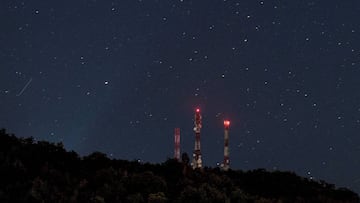Perseid Meteor Shower: watch and follow live online

Perseid meteor shower: watch live online 13 August 2020
Where to watch yourself
To watch the Perseid meteor shower yourself, the best plan is to grab a folding chair to sit in as you scan the sky and head out of the city if you don't already live in the countryside. Try and get as far away froth city lights as possible. If you've got a properly dark sky you could see up to 100 meteors an hour, so over one a minute and at times you might be lucky enough to see several streaking across the sky at the same time.
Don't worry if you can't get away from the city, you should still see a fair few shooting stars. Last night in Madrid for example between three and four in the morning there were at least 20 easily visible.
Watch out for the moon and let your eyes adjust
The moon will be a slight nuisance for watching the meteors tonight, but it shouldn't ruin the display. If you can, just get a barn or rocks or a mountain between you and the moon so its light doesn't get into eyes.
Remember your eyes need up to 20 minutes to truly adjust to the dark, so give yourself time. The meteors often come in bursts too, so don't give up if you've seen nothing after five minutes. They will come!
Also, don't be tempted to look at your phone once you are in position, every time you glance at it, your eyes will take time to adjust to the dark again and you might miss the fainter meteors.
Good luck!
Which way to look
The meteor shower originates in the part of the sky where the constellation Perseus is to be found, hence the name of the meteor shower, although the constellation, made up of stars many light years away have nothing physically to do with the meteors.
You could look up a star chart or download a sky viewer app on your phone to find Perseus, but in reality you don't need to do so. If you look roughly north-east you're looking in the right direction and the meteors can be spotted across a wide arc of the sky, so keep your peripheral vision alert!
Remember, your smart phone likely has a compass app if you've lost your bearings and can't find north-east.

When to watch
The best time to see the meteors is in the hours just before dawn, although you will see meteors all night, with the amount increasing after midnight. In the southern hemisphere you are unlikely to see any before midnight.
When to watch
The best time to see the meteors is in the hours just before dawn, although you will see meteors all night, with the amount increasing after midnight. In the southern hemisphere you are unlikely to see any before midnight.
Where to watch
To watch the Perseid meteor shower yourself, the best plan is to grab a folding chair to sit in as you scan the sky and head out of the city if you don't already live in the countryside. Try and get as far away froth city lights as possible. If you've got a properly dark sky you could see up to 100 meteors an hour, so over one a minute and at times you might be lucky enough to see several streaking across the sky at the same time.
Don't worry if you can't get away from the city, you should still see a fair few shooting stars. Last night in Madrid for example between three and four in the morning there were at least 20 easily visible.
Swift-Tuttle: the most dangerous object...
Don't look for the Comet Swift-Tuttle though at the moment, it's roughly still 6,007,156,900 km from the Earth, though it will be back in 2026, when it will be visible to the naked eye.
Don't worry about Swift-Tuttle too much, but it has been described as the "the single most dangerous object known to humanity" due to how close it comes to us when it swings past on its trip round the Sun. Experts however reckon it will only come within 22 million kilometres of us in 2026, though in 3044 it will come to within a million kilometres...
All thanks to the Comet Swift-Tuttle
A fixture in the heavens in early August, the Perseid meteor shower is caused by the Earth moving through the dust and debris left by the Comet Swift-Tuttle. The small particles of ice and rock from the comment hit our atmosphere at over 200,000 km/hr and rapidly burn up, causing the shooting stars that can be clearly seen without the aid of binoculars or telescopes.
Perseid meteor shower live
Hello and welcome to our live footage of the Perseid meteor shower, where we'll bring you the best video footage of tonight's celestial display.





